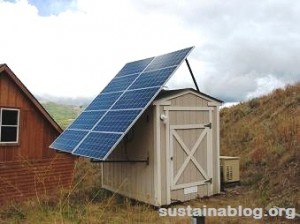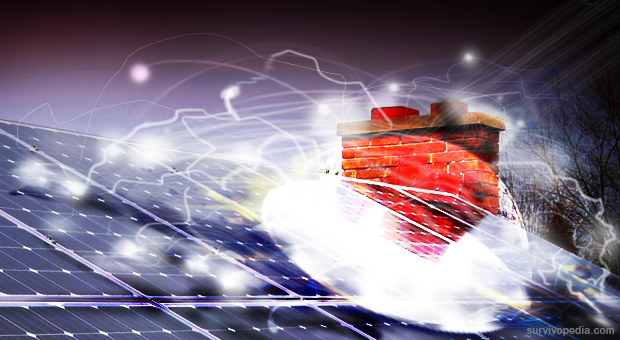Our country’s way of life and most people aren’t prepared to survive when an EMP will cripple the entire U.S. power grid and kill electric equipment in the entire country. Protecting your solar gear makes the big step ahead to your survival.
You might choose to start with an easy, inexpensive project right now such as constructing a DIY Faraday cage for your solar panels, or tuck a few mission-critical solar gadgets inside a couple of layers of Faraday bags to go in your rucksack. We already explained how to do it, in the first part of this article.
Next in increasing order of cost, complexity and difficulty, are solar panel installations on homes or retreats which are not connected to the grid. For this type of application we will shield the solar panels themselves, all associated wiring, inverter hardware, the battery bank and as little space as a couple of rooms or as much as the entire building.
How It Works
Shielding large spaces is most easily and least expensively accomplished in the design and building phases of the home and its solar power system as opposed to retrofitting an existing home and installing solar panels on it.
By creating a larger envelope of shielding, with the same shielding properties as a Faraday cage, all of the electronic devices in the shielded portion of the building will be protected. Shielding large spaces eliminates redundant purchases and the hassle of storing spare electronics in a Faraday cage for possible future use. Also, you don’t ned to shield dozens of devices individually nor install surge protection and shielded wiring between them.
To shield against the maximum theoretical EMP field strength (50 thousand volts per meter) of known NHEMP detonations, we must shield our solar panels to 74dB over a frequency range below 64Mhz.
But shielding them to 80dB will give us a margin of error since our shielding will likely become somewhat compromised over time and by the wear and tear of life and the elements.
Shielding Solar Panels for an Off-Grid Retreat
 To shield our grid-independent retreat, the entire outer skin of the structure must be shielded to our target 80dB.
To shield our grid-independent retreat, the entire outer skin of the structure must be shielded to our target 80dB.
The entire roof, the exterior of all of the walls and the floor must all be shielded.
This will obviously be much easier to accomplish during the design and construction phases and can be accomplished by choosing conductive construction materials and methods which provide the needed shielding and lack of impedance, such as:
- Conductive metal roofing materials
- Conductive paint
- Conductive metal doors, door frames and conductive gaskets
- Conductive matting laid over the foundation or skin applied to the bottom of the sub-floor
- Conductive bonds, joints, brackets, gaskets and seals must be used to joint different materials
- Conductive window frames must be used
- Conductive window film or 2 layers of 20 opening per inch wire screening covering windows but still allowing light to pass through them and an unobstructed view will still providing the requisite level of shielding,
- 2 layers of conductive 20 opening per inch wire screening covering the solar panels will allow light transmission to the panels while still providing the requisite shielding. 2 layers will protect against construction mistakes and wear.
The outside skin of all walls must be shielded or the wiring within the walls will conduct the EMP into the electrical system. If less than the entire structure is shielded, the shielded rooms must be wired independently of the rest of the house or the use of costly fast-clamping surge protection equipment will be necessary to isolate the shielded rooms

The building should be properly grounded because of its large area.
Install micro-inverters underneath the shielded skin that envelops each solar panel instead of a single, and large inverter cabinet that rests on a cement pad next to the structure. You will increase redundancy and avoid shielding the inverter cabinets, and installing surge suppression and shielded wiring.
Shielding Solar Panels for a Grid-Connected Location
The most difficult and expensive solar installation is the protection of is a grid-connected home or building.
The same principles apply to this project as applied to the simpler projects but since the home and its solar energy system is connected to the power grid, this one requires additional protective measures.
This installation will be more vulnerable to the power charges induced by E3 because it is grid connected. For that reason, in addition to the measures taken in the previous projects, keep take good care of the following:
- The home’s connection to the power grid should have a mechanical, manual bypass circuit allowing the home to be physically disconnected from the grid.
- The home’s connection to the power grid must be fitted with the fast-clamping surge suppression previously mentioned.
- In order to deal with the power company, the home will need an electric meter. If a smart meter with a data connection is installed, the data connection would also need to be surge protected.
- Being more along the lines of a remote cabin, the last model was assumed to be pretty self-contained. Grid-connected homes typically have more connections penetrating the shielded envelope in addition to power such as copper phone lines, cable TV, satellite TV, radio antennas, etc.. An external cellular antenna will be necessary. A cell signal repeater located inside the shielded home will also be needed since virtually no signals of any kind will penetrate the home’s shielding.
- Non-conductive water and sewer pipes should be used where they penetrate the shielding envelope. EMP trapping baffles could be constructed where non-conductive pipe penetrations occur to reduce the amount of EMP entering through these points.
- Fiber optic cabling can be substituted for copper data and voice cable runs since fiber optic cable is non-conductive and will not conduct surges caused by E3 EMP inside the shielding envelope.
- Shielded foyers, mud rooms or rotating doors should be installed at entrances and exits. Passing through 2 shielded doors to enter the building, but allowing only 1 door to open at any given time will maintain the envelope. It would be a shame to go to all the cost and trouble of this level of protection just to have an EMP occur when the door is open and compromise the contents of the structure.
This last type of installation will raise the cost of a new home by about 30% including the cost of adding a solar installation with a battery bank and backup generator. But the added cost would be recouped over time through savings on future electrical bills and it is hard to put a price tag on piece of mind and the ability to maintain your standard of living after an EMP.
Of course, costs would increase for a retrofit in proportion to the complexity of the build and the amount of material needed.
With a little knowledge, insight and preparation, you can protect your solar panels from the effects of EMP. Whatever your income and the level of complexity of your solar installation, there is a solution.
Take this knowledge to prepare yourself or your family now so that you and yours are less vulnerable in the event of an EMP.
Find out which devices are most vulnerable to EMP on “Darkest Days”.
This article has been written by Cache Valley Prepper for Survivopedia.
About Cache Valley Prepper
Cache Valley Prepper is a full-time survival and self-defense consultant, instructor and writer, but primarily identifies himself as a lifelong student of survival. He is profoundly grateful to his mentors for afflicting him with an insatiable curiosity about all things self-reliant but claims to be allergic to conspiracy theory. He is a talented competitive shooter, has a profound love of nature, and likes to backpack, camp, hunt and pursue outdoor hobbies. He studies and trains constantly and loves that his work enables him to get in plenty of “dirt time” all over the world … even if it means he has to work a little while he plays. Cache is a volunteer emergency responder in a small town without any paid services and holds numerous instructor and student certifications in everything from emergency management to less-lethal munitions and high explosive breaching. Cache Valley Prepper is a pen name used to protect his identity.





